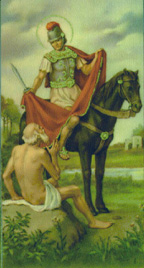We ask you, humbly: don't scroll away.
Hi readers, it seems you use Catholic Online a lot; that's great! It's a little awkward to ask, but we need your help. If you have already donated, we sincerely thank you. We're not salespeople, but we depend on donations averaging $14.76 and fewer than 1% of readers give. If you donate just $5.00, the price of your coffee, Catholic Online School could keep thriving. Thank you.Help Now >
Nicolas Poussin
FREE Catholic Classes
French painter, b. at Les Andelys near Rouen in 1594; d. at Rome, 19 November, 1666. His early history is obscure; his father had been a soldier, his mother was a peasant. In 1612, Varin, a wandering painter, brought him to Paris, where he experienced great distress. In despair he tried his fortune in the provinces but nothing remains of what he did at that time in Poitou and later with the Capuchins at Blois, as well as the six pictures he painted in eight days for the Jesuit college at Paris. He studied under Varin, Lallemand, and Ferdinand Elle, but they had no share in his development. The French school was then in a languid condition. The religious wars of the time rendered abortive the attempt of Francis I to inaugurate the Renaissance, and Henry IV had other things to engross his attention besides the arts. His successor sought rather such foreign artists as John of Bologna, Pourbus, and Rubens. At this juncture Poussin learned of some engravings by Marc Antonio after Giulio Romano and Raphael. This was his road to Damascus. Antique beauty was revealed to him through the works of these sons of Italy and thenceforth he lived in the past. All modern civilization seemed barbarous to him. His experience was an illumination, a veritable conversion. Henceforth he had no rest until he found the fatherland of his heart and his ideas. Three attempts he made to reach Rome. Compelled to return to Paris he there encountered Marini, the famous author of the "Adonis", who contracted a warm friendship for the enthusiastic boy: "Che ha", said he, "una furia di diavolo". With him he finally reached Rome in 1624; but Marini died within a few months and Poussin was alone in a strange city, helpless, ill, without means, and reduced to doing hack work. The poor artist then met a countryman, the cook Dughet, who took pity on him, sheltered and cured him, and whose daughter he married (1629).
At the time of his arrival at Rome the school was divided into two parties, that of the mannerists who followed Guido, and that of the brutal naturalists who followed Caravaggio, both in Poussin's opinion quackery, equally dishonest and remote from reality. He detested the affected airs of the fashionable painters, their sentimentality, their insipidity, their ecstasy. Nor was he less hard on the affectation of the "naturalists and their partiality for ugliness and vulgarity". He called Caravaggio's art "painting for lackeys", and added: "This man is come to destroy painting ". Both schools sought to execute more beautifully or more basely than nature ; Art was endangered for lack of rule, conscience, and discipline. It was time to escape from caprice and anarchy, from the despotism of tastes and temperaments. And this was what Poussin sought to achieve by his doctrine of "imitation". To imitate the antique was an approach to nature, to learn conformity with reality, to recover life in its most lasting, noble, and human forms. Such at least was the doctrine and faith which he practised unceasingly in his works and letters. For this he became an archeologist, a numismatist, a scholar. He used scientific methods, measuring statues, consulting bas-reliefs, studying painted vases, sarcophagi, and mosaics. Every point was based on an authentic document. In this he was doubtless influenced by a certain narrowness and misunderstanding of the claims of realism. To a certain extent his art is for the initiated, the taste for it requires culture. More, this pure ideal implies a singular anachronism. Poussin presents the strange case of a man isolated in the past and who never descended in history lower than the Antonines. By his turn of mind this man of austere virtue was scarcely Christian. He rarely painted scenes from the Gospel. His Christ is certainly one of his weakest types. Let me dare to say it: as an artist Poussin thinks somewhat like a Leconte de Lisle or like the Renan of the "Prière sur l'Acropole". Poussin had no desire to see the modern world. He left but a single portrait, his own. He is wholly expressed in Bernini's words: "Veramente quest' uomo à stato grande istoriatore e grande favoleggiatore". He was a great historian, a great teller of fables, an epic poet, in a word the foremost of his time and one of the foremost of all time.
His works are very numerous. The first group contains subjects borrowed from sacred and profane antiquity. Among these to mention only dated works are: "The Rape of the Sabines", and "The Plague of the Philistines" (1630, Louvre); "The Testament of Eudamidas" (Copenhagen); "Hebrews Gathering Manna" (1639); "Moses Rescued from the Waters" (1647); "Eliezer and Rebecca" (1648); "The Judgment of Solomon" (1649); "The Blind Men of Jericho" (1650); "The Adulteress" (1653); all these last-named pictures are at the Louvre. To these must be added the important double series of pictures known as the "Seven Sacraments ". The first, painted (1644-8) for Cavaliere del Pozzo, is now at the Bridgewater Gallery, London. The second is a very different variation of the former and was painted for M. de Chantelou, his correspondent and active protector. It is now in collection of the Duke of Rutland at Belvoir Castle. This historical portion of his work seems to have been most in favour with his contemporaries. It immediately became classic and it is certainly filled with the highest beauty. Despite their high and strong qualities, however, these works no longer attract us, for we often find therein an intellectual affront, a something too literary or too rationalistic which seems to us foreign to the genius of painting. But that this was relished by the French of the seventeenth century is shown by their commentaries on these works. The description of the two pictures "Eliezer" and the "Manna", fills forty quarto pages in Félibien. Apart from these historical scenes which "relate" and "prove" there is a purely lyric side. In it are evident the wonderful skill of the designer and the poet, detached from any attempt at anecdote or "illustration". Such were the "Bacchanalia", the "Triumph of Flora", the "Childhood of Jupiter", which do little more than repeat the theme of the joy and beauty of living. Here Poussin's genius freed of all restraint can only be compared to that of great musicians such as Rameau or Gluck. Properly speaking it is the genius of rhythm. This is his true sphere, as original as that of any master, and the inexhaustible source of his emotion and poetry. In a sense his work may be considered as a ballet. This was his idea in his famous letter on the modes of the ancients, who distinguished as many as seven, the Dorian, Phrygian, Lydian, Hypolydian etc. "I desire", he added, "before another year to compose a picture in the Phrygian manner". This phrase would have aroused less amusement if Whistler's works, with his "symphonies", "harmonies", "nocturns", and "sonatas", had been known. But this music of painting which Whistler made chiefly a matter of colour seemed to Poussin a question of movement. For him it meant life understood as a dance which the Greeks made a science.
Finally the landscape becomes more and more important in this lyrical or poetical side of his work. Nature accompanies with its profound harmony the human sentiments which transpire on its surface, the persons are merely a melodious figure outlined against the chorus of things. As a landscape artist he is without a peer, unless it be Titian. Constable finds something religious in his landscapes; in fact, when contemplating his "Polyphemus" or his "Cacus" (St. Petersburg), it is easy to understand (what no one since Virgil has felt) the naturalistic and mysterious origin of myths. Beyond doubt this is something far removed from the pious Franciscan tenderness as it finds expression in the "Canticle of creatures"; it is rather the religion of Epicurus or Lucretius, which teaches conformity with the ends of the universe and as supreme wisdom counsels harmony with the rhythm of nature. Towards the end of his life Poussin seems to have renounced the personal or dramatic element. His last works, the "Four Seasons" of the Louvre (1664-65), are simply four landscapes which please by variety of sense. Like the ancient sage the master leaves history and psychology, and devotes himself simply to music. Between 1624 and his death he was absent from Rome only once (1641-2) at the command of Richelieu, who summoned him to Paris to superintend the work at the Louvre with the title of painter to the king. This journey was otherwise unfortunate. The artist was misunderstood by the painters, who soon succeeded in driving him away. All that remains of this period are two large pictures, a "Last Supper", very mediocre, painted for St. Germain en Laye, a "Miracle of St. Francis Xavier ", painted for the Jesuit novitiate, and a ceiling, the "Triumph of Truth ", painted for Richelieu's chateau at Rueil. These three canvases are at the Louvre. On his return to Rome Poussin found his authority much increased by his official title. He lived not far from the Trinità dè Monti in a little side street where he had as neighbors Claude Lorrain and Salvator. Among artists he exercised a singular influence. Nearly all the Frenchmen who came to Rome to study, from Mignard to Le Brun and Sebastien Bourdon, not to mention his brother-in-law Gaspard Dughet (called "Guaspre"), imitated him and claimed him as master; but as usual none of them understood him. In his century he was an isolated genius, but his glory has not been useless to us; it shone more brilliantly in the decadence of the Italian school and it gave to the French school what it had hitherto lacked — titles and an ancestor.
Join the Movement
When you sign up below, you don't just join an email list - you're joining an entire movement for Free world class Catholic education.
-

-
Mysteries of the Rosary
-
St. Faustina Kowalska
-
Litany of the Blessed Virgin Mary
-
Saint of the Day for Wednesday, Oct 4th, 2023
-
Popular Saints
-
St. Francis of Assisi
-
Bible
-
Female / Women Saints
-
7 Morning Prayers you need to get your day started with God
-
Litany of the Blessed Virgin Mary
The Power of the Rosary: Why Praying the Rosary Matters for Catholics
-

Lasers Reveal Hidden Mayan City of Valeriana with 6,500 Structures in Mexico
-

Embracing Peace and Unity in a Time of Division
-
The 'Black Legend': Historian Argues Anti-Catholic Bias in Spanish Conquest Narratives
-
This Catholic Hero Who Fought Against Communism Should Be Released Immediately
Daily Catholic
 Daily Readings for Monday, November 11, 2024
Daily Readings for Monday, November 11, 2024 St. Martin of Tours: Saint of the Day for Monday, November 11, 2024
St. Martin of Tours: Saint of the Day for Monday, November 11, 2024 Prayer for Deceased Veterans: Prayer of the Day for Monday, November 11, 2024
Prayer for Deceased Veterans: Prayer of the Day for Monday, November 11, 2024- Daily Readings for Sunday, November 10, 2024
- St. Leo the Great: Saint of the Day for Sunday, November 10, 2024
- Evening Prayers: Prayer of the Day for Saturday, November 09, 2024
![]()
Copyright 2024 Catholic Online. All materials contained on this site, whether written, audible or visual are the exclusive property of Catholic Online and are protected under U.S. and International copyright laws, © Copyright 2024 Catholic Online. Any unauthorized use, without prior written consent of Catholic Online is strictly forbidden and prohibited.
Catholic Online is a Project of Your Catholic Voice Foundation, a Not-for-Profit Corporation. Your Catholic Voice Foundation has been granted a recognition of tax exemption under Section 501(c)(3) of the Internal Revenue Code. Federal Tax Identification Number: 81-0596847. Your gift is tax-deductible as allowed by law.








 Daily Readings for Monday, November 11, 2024
Daily Readings for Monday, November 11, 2024 St. Martin of Tours: Saint of the Day for Monday, November 11, 2024
St. Martin of Tours: Saint of the Day for Monday, November 11, 2024 Prayer for Deceased Veterans: Prayer of the Day for Monday, November 11, 2024
Prayer for Deceased Veterans: Prayer of the Day for Monday, November 11, 2024

